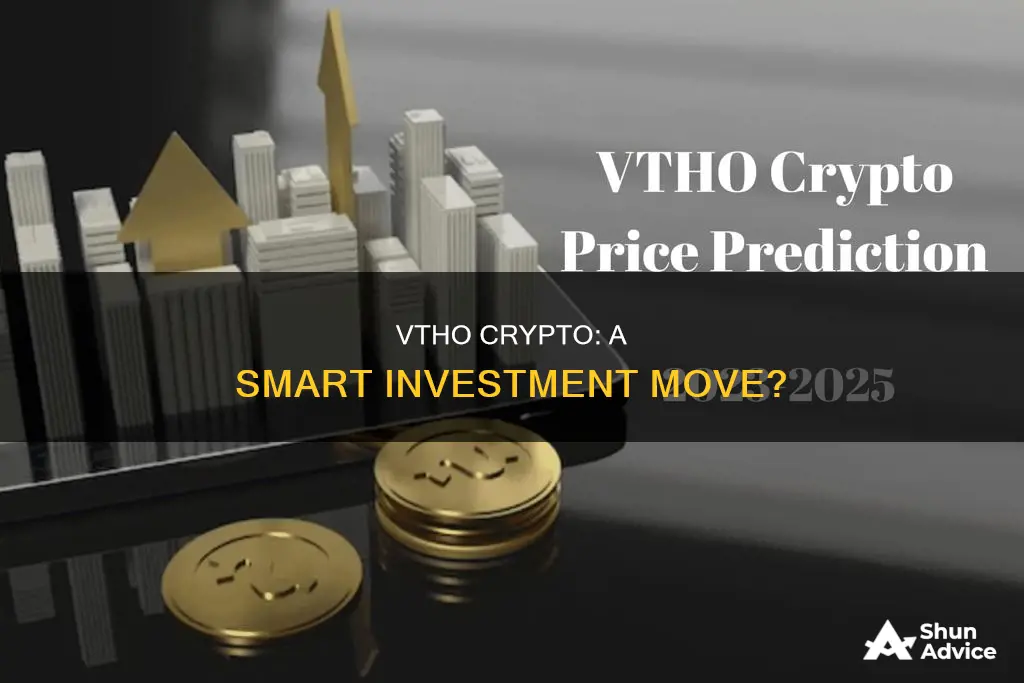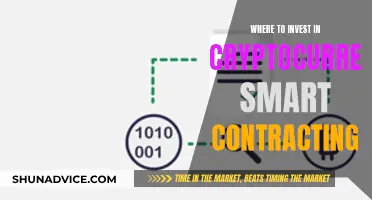
VeThor Token (VTHO) is one of two native tokens on the VeChainThor blockchain, which was launched in 2015 and rebranded in 2018. The other native token is VeChain Token (VET). While VET is the primary value-transfer token, VTHO is crucial to the blockchain's functionality, facilitating transactions and smart contract execution. VTHO is also used to pay network gas fees.
VTHO is a VIP-180 Standard token, which means it is a unique ERC20 token. It is traded on multiple exchanges, including Binance, Bitvavo, BitMart, Crypto.com, and Gate.io.
The current price of VTHO is $0.002095 USD, with a 24-hour trading volume of $929,915 USD. Its all-time high was $0.0420.
The price of VTHO is expected to rise in the coming years, with some sources predicting it will reach $0.0052 by 2024, $0.0167 by 2027, and $0.1651 by 2033.
However, it is important to remember that the cryptocurrency market is highly volatile, and past performance is not indicative of future results. Before investing in VTHO or any other cryptocurrency, be sure to do your own research and understand the risks involved.
What You'll Learn

VTHO's price history and predictions
The VeThor Token (VTHO) is one of the two native tokens on the VeChainThor blockchain, which was launched in 2015 and rebranded in 2018. The other token is the VeChain Token (VET). The VeThor Token is a VIP-180 Standard token, which represents the cost of using the VeChainThor blockchain. Its primary purpose is to facilitate processes and transactions on the blockchain, and it essentially represents the smart contract layer of the network.
The VeChainThor blockchain boasts increased processing speeds and an open-source design, allowing developers to pool their efforts. The blockchain also has meta-transaction features that allow users to conduct multi-party transactions involving multiple tasks. The blockchain also allows smart contracts to be executed using the VTHO.
The VeThor Token is directly derived from the VET token. In order for transactions to be processed on the VeChainThor blockchain, a part of a VTHO token is created for every VET token added to the block. This means that 0.00000005 VTHO is generated per VET per block. The maximum VET supply is 86,712,634,466 tokens, while the VTHO supply is significantly lower at 31,946,532,533 tokens.
The VeChainThor network relies on a proof-of-authority (PoA) consensus mechanism, which allows it to validate transactions more swiftly. The PoA consensus relies on approval from an Authority Masternode (AM), which is selected by the VeChain Foundation. Both VET and VTHO tokens are a special class of ERC-20 coins, which means they can be stored in various hot and cold cryptocurrency wallets.
The current price of VTHO is $0.002095, with a 24-hour trading volume of $929,915. The token is up 0.45% in the last 24 hours, but down 3.56% in the past 24 hours and 2.49% in the past week. The all-time high of VTHO is $0.0420, and the current market cap is $191.84 million.
Looking at price predictions, Cryptopolitan forecasts that VTHO will rise above $0.005 at its peak in 2024, reaching $0.0052. In 2027, it will trade at the $0.0142 mark on average, and in 2030, it will trade at the $0.0445 mark on average. By 2033, VTHO's price will trade at the $0.1419 mark on average.
WalletInvestor gives VTHO a past performance index rating of C and predicts that it will make a very good one-year investment, averaging at $0.00427 next year. CryptoPredictions is bullish on VTHO, indicating that it will have decimal gains over the next four years, ranging between $0.004 and $0.013. DigitalCoinPrice predicts that the maximum price for the period 2024-2033 is $0.0624, and that the coin will break the $0.01 resistance in 2026 and $0.02 in 2030.
Binance, a leading crypto exchange, is bullish on VTHO's average price over the next six years. The coin growth is modest, with 2030 averaging at $0.003169.
AOA Coin: Is it a Worthy Investment?
You may want to see also

VTHO's value and market cap
The VeThor Token (VTHO) is one of the two native tokens on the VeChainThor blockchain, the other being VeChain Token (VET). VTHO is a crucial component of the VeChainThor public blockchain, which was launched in 2015 and rebranded in 2018.
VTHO is an essential part of the blockchain's functionality, facilitating processes and transactions, and representing the smart contract layer of the network. It is also used to pay network gas fees.
The current price of VTHO is $0.002095, with a 24-hour trading volume of $929,915. Its market cap is $169,724,150, with a circulating supply of 81,000,045,658 VTHO coins. The maximum supply is not available.
VTHO's price has been volatile, with an impressive performance in the early 2024 bull cycle, rising over 300% from 2023's lows. However, the performance was tied to market sentiment rather than the coin's inherent utility. VTHO's price is expected to continue to be influenced by the performance of Bitcoin and the broader market.
The VeChainThor blockchain boasts increased processing speeds and an open-source design, allowing developers to collaborate. The platform also features meta-transaction capabilities, enabling multi-party payments and multi-task transactions. This versatility benefits enterprise users of all levels, allowing them to utilise blockchain capabilities effectively.
The dual-token design of VeChainThor allows users to engage with both tokens, diversifying their interaction with the platform. The VTHO token is directly derived from the VET token, with 0.00000005 VTHO generated per VET token added to the block. This keeps the circulating supply of VTHO at a relatively low level, maintaining high demand for the token.
The VeChainThor network relies on a proof-of-authority (PoA) consensus mechanism for swift transaction validation. The foundation of the blockchain is influenced by the Ethereum Virtual Machine (EVM) and some concepts employed by the Ethereum blockchain. The PoA consensus relies on approval from an Authority Masternode (AM) selected by the VeChain Foundation.
VTHO tokens can be traded on centralised crypto exchanges, with Binance being the most popular exchange. However, it is important to note that trading cryptocurrencies carries risks like any other investment.
Big Players Betting on Bitcoin: Who's Investing?
You may want to see also

VTHO's pros and cons
VTHO's Pros
- VTHO is one of the two native tokens on the VechainThor blockchain, which is an energy-efficient, sustainable network that global enterprises and governments can use to leverage smart contracts and decentralised applications.
- VTHO is a crucial component of the VeChainThor public blockchain, a platform that strives to enhance the functionality of blockchain technology.
- VTHO is generated for every VET token added to the block, facilitating transactions on the VeChainThor blockchain.
- VTHO is integral to the operation of the VeChainThor blockchain, facilitating transactions and smart contracts execution.
- VTHO's primary use case is to represent the cost of using the VeChainThor blockchain.
- The VeChainThor blockchain aims to improve processing speeds and an open-source design, allowing developers to collaborate.
- The platform also developed meta-transaction features, which seek to enable multi-party payments and multi-task transactions. This versatility seeks to benefit enterprise users of all levels, allowing them to utilise blockchain capabilities.
- VTHO is paid as a form of a dividend to every holder of VET tokens, the native currency of the VeChain ecosystem.
- VTHO is used to pay network gas fees.
- VTHO is a VIP-180 Standard token, which represents the cost of using the VeChainThor blockchain.
- The VeChainThor blockchain boasts increased processing speeds and an open-source design, allowing developers to pool together their efforts.
- The VeChainThor blockchain uses a proof-of-authority (PoA) consensus mechanism, which allows it to validate transactions more swiftly.
- The PoA consensus relies on approval from an Authority Masternode (AM), which is selected by the VeChain Foundation.
- Both VET and VTHO tokens are a special class of ERC-20 coins, meaning they can be stored in various cryptocurrency wallets.
- VTHO can be purchased from major exchanges.
- VTHO is projected to increase in value over time.
VTHO's Cons
- VTHO is not mineable.
- VTHO is not directly related to the market value of VET.
- VTHO is not available on all exchanges.
- VTHO has a low supply.
- VTHO's price is affected by the market price of Bitcoin.
- VTHO's price is volatile.
- VTHO's value is derived from its utility, not speculation.
- VTHO's transaction fees are subject to change.
- VTHO's value is dependent on the success of the VeChainThor blockchain.
The Next Bitcoin: Will We Ever See Similar Growth?
You may want to see also

VTHO's use cases
VTHO is one of two native tokens on the VeChainThor blockchain, the other being VET. VeChainThor is a public blockchain that allows members to participate by solving real-world problems. It was founded in 2015 under the name VeChain by Sunny Lu, ex-COO of Louis Vuitton China, before being rebranded to VeChainThor in 2018.
The VeChainThor blockchain uses a proof-of-authority (PoA) consensus mechanism, which depends on authority controller nodes selected by the VeChainThor foundation to validate transactions and add blocks to the blockchain. The PoA mechanism enables VeChainThor to process transactions at record speeds.
VTHO is a VIP-180 Standard token, which represents the cost of using the VeChainThor blockchain. Its primary purpose is to facilitate processes and transactions on the blockchain, and it essentially represents the smart contract layer of the network. VTHO is needed to pay for writing data to the VeChainThor blockchain. This means that every transaction (sending tokens or sending data to a smart contract) must be paid for in VTHO. The amount of VTHO needed for a transaction depends on the size of the data being sent. A simple VET transaction costs around 30 VTHO, while sending a transaction filled with data to a smart contract can cost 1000 VTHO.
The VeChainThor blockchain boasts increased processing speeds and an open-source design, allowing developers to pool their efforts. In addition, VeChainThor developed meta-transaction features that allow participants to organise multi-party payments and multi-task transactions. This versatility allows enterprise users of all levels to benefit from blockchain capabilities.
The VeChainThor network benefits from the dual-token design, as transactions and smart contracts are executed thanks to the VTHO token, which is not directly related to the market value of VET. The dual-token design on the VeChainThor blockchain enables users to trade using two tokens, thus diversifying their investment portfolios.
The whole idea of a two-coin system is that this allows the transaction fees to remain relatively stable, compared to a system where there is only one coin. Taking Ethereum as an example, during last year's bull run, the price of Ethereum rose to over $1000. This caused the average transaction fee to become over $1, compared to its current fee of $0.10. This is a big problem for anyone wanting to use the Ethereum blockchain!
The cost of a transaction can be calculated using the following formula:
Transaction cost = VTHO price x amount of VTHO needed
This allows for two mechanisms to keep the transaction costs stable:
- Increase the VTHO generation rate: By increasing the VTHO generation rate, more VTHO will hit the market, potentially lowering the VTHO price and bringing the transaction cost down.
- Change the amount of VTHO needed: By increasing or decreasing the amount of VTHO that is required for a transaction, the transaction cost can also be influenced.
Both changes have to be agreed upon by all stakeholders (enterprises, dApp owners, VET holders and Authority Nodes) of the ecosystem. Using a decentralised vote, everyone can vote if they agree to the change. Only when the majority agrees will the Foundation decide to change the parameters.
Is Bitcoin a Safe Investment?
You may want to see also

How to buy VTHO
To buy VTHO, you will need to open an account with a cryptocurrency exchange that supports VTHO, such as Binance, Gate.io, Crypto.com, Coinbase, Bitvavo, BTCC, Bybit, BYDFi, 4E, MEXC, or BitMart.
Once you have chosen an exchange, you will need to create an account by providing necessary information, including your email address, creating a secure password, and completing any identity verification steps. It is important to research the exchange's reputation and read user reviews before creating an account.
After creating your account, you will need to choose a funding method to buy VTHO. Common options include credit or debit card, bank deposit, P2P trading, or third-party payment channels. Keep in mind that not all exchanges offer the same payment methods, so you may need to refer to the exchange's FAQ section.
Next, you can place an order to buy VTHO. Most exchanges will have a "Buy & Sell" section where you can select the cryptocurrency you want to purchase. Different exchanges offer different types of orders, but the simplest option is usually a market order, which will purchase VTHO at the current rate.
Finally, once you have purchased VTHO, you can choose to hold it in your exchange account or transfer it to a private cryptocurrency wallet for safekeeping.
Additional Considerations
- It is important to remember that investing in cryptocurrency carries risks, and the market is highly volatile.
- Always conduct your own research and consult multiple sources before making any investment decisions.
- Be sure to compare different exchanges to find the one that best suits your needs in terms of fees, available payment methods, and supported currencies.
- Some exchanges may have restrictions on users from certain countries, so be sure to check if your chosen exchange is available in your region.
Dragons' Den Bitcoin Code: Did They Invest?
You may want to see also







